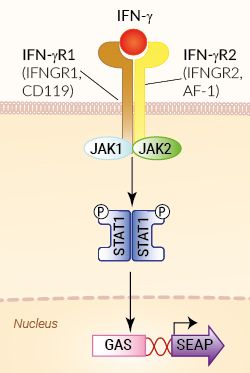IFN-γ Reporter HEK 293 Cells
| Product | Unit size | Cat. code | Docs. | Qty. | Price | |
|---|---|---|---|---|---|---|
|
HEK-Blue™ IFN-γ Cells Human IFN-γ cytokine HEK293 reporter cells |
Show product |
3-7 x 10e6 cells |
hkb-ifng
|
|
||
|
HEK-Blue™ IFN-γ vial Additional cell vial |
Show product |
3-7 x 10e6 cells |
hkb-ifng-av
|
Notification: Reference #hkb-ifng-av can only be ordered together with reference #hkb-ifng.
Human Type II IFN Reporter Cells

Signaling pathway in HEK-Blue™ IFN-γ cells
HEK-Blue™ IFN-γ cells were engineered from the human embryonic kidney HEK293 cell line to detect the bioactive human type II interferon IFN-γ by monitoring the activation of the JAK/STAT1 pathway. In addition, these cells can be used for screening antibodies or small molecule inhibitors targeting the IFN-γ pathway.
IFN-γ is a pleiotropic cytokine with anti-viral, anti-tumor, and immunomodulatory functions [1].
Cell line description
HEK-Blue™ IFN-γ cells were generated by stable transfection with the genes encoding the human STAT1 to obtain a fully active type II IFN signaling pathway. The other genes of the pathway (IFNGR1, IFNGR2, JAK1, and JAK2) are naturally expressed by these cells. HEK-Blue™ IFN-γ cells were also stably transfected with a STAT1-inducible secreted embryonic alkaline phosphatase (SEAP) reporter. The binding of IFN-γ to its receptor triggers a signaling cascade leading to the activation of STAT1 and the subsequent production of SEAP. This can be readily assessed in the supernatant using QUANTI-Blue™ Solution, a SEAP detection reagent.
HEK-Blue™ IFN-γ cells respond to human but not murine IFN-γ. Of note, these cells do not respond to either type I IFNs (IFN-α/β) or type III IFNs (IFN-λ) (see figures).
Key Features
- Fully functional IFN-γ signaling pathway
- Readily assessable STAT1-inducible SEAP reporter activity
- Strong response to human IFN-γ
- No response to murine IFN-γ
- No response to IFN-α/β (type I IFNs) and IFN-λ (type III IFNs)
Applications
- Detection of human IFN-γ
- Quantification of IFN-γ activity in biological samples, such as plasma or serum [2]
- Screening of anti-IFN-γ and anti-IFNGR antibodies
- Screening of small molecule inhibitors of the IFN-γ pathway
References:
1. Ivashkiv L.B., 2018. IFNγ: signalling, epigenetics and roles in immunity, metabolism, disease and cancer immunotherapy. Nat Rev Immunol. 18(9):545-558.
2. Gómez-Bañuelos E, et al., 2024. Uncoupling interferons and the interferon signature explain clinical and transcriptional subsets in SLE. medRxiv. 2023.08.28.23294734
Specifications
Antibiotic resistance: Blasticidin, Zeocin®
Growth medium: DMEM, 4.5 g/l glucose, 2 mM L-glutamine, 10% (v/v) heat-inactivated fetal bovine serum, 100 U/ml penicillin, 100 µg/ml streptomycin, 100 µg/ml Normocin®
Specificity: Detects human IFN-γ
Detection range:
- Detection range for human IFN-γ: 0.1 ng/ml - 10 ng/ml
Quality Control:
- SEAP reporter activity in response to IFN-γ is validated using functional assays.
- The stability for 20 passages following thawing is confirmed.
- These cells are tested for mycoplasma contamination.
Contents
- 1 vial containing 3-7 x 106 cells
- 1 ml of Blasticidin (10 mg/ml)
- 1 ml of Zeocin® (100 mg/ml)
- 1 ml Normocin® (50 mg/ml)
- 1 ml of QB reagent and 1 ml of QB buffer (sufficient to prepare 100 ml of QUANTI-Blue™ Solution, a SEAP detection reagent)
![]() Shipped on dry ice (Europe, USA, Canada and some areas in Asia)
Shipped on dry ice (Europe, USA, Canada and some areas in Asia)
Details
Interferon-gamma (IFN-γ), a Type II interferon, is secreted from CD4+ T-helper 1 (Th1) cells and activated natural killer (NK) cells. It plays a role in activating lymphocytes to enhance anti-microbial and anti-tumor effects [1-3]. In addition, IFN-γ plays a role in regulating the proliferation, differentiation, and response of lymphocyte subsets.
IFN-γ exerts its action by first binding to a heterodimeric receptor consisting of two chains, IFNGR1 and IFNGR2, causing its dimerization and the activation of specific Janus family kinases (JAK1 and JAK2) [4, 5]. Two STAT1 molecules then associate with this ligand-activated receptor complex and are activated by phosphorylation. Activated STAT1 forms homodimers and are translocated to the nucleus where they bind interferon-gamma-activated sites (GAS) in the promoter of IFN-γ inducible genes.
1. Ivashkiv L.B., 2018. IFNγ: signalling, epigenetics and roles in immunity, metabolism, disease and cancer immunotherapy. Nat Rev Immunol. 18(9):545-558.
2. Shtrichman R. & Samuel CE., 2001. The role of gamma interferon in antimicrobial immunity. Curr Opin Microbiol. 4(3):251-9.
3. Sato A. et al., 2006. Antitumor activity of IFN-lambda in murine tumor models. J Immunol. 176(12):7686-94.
4. Platanias L.C., 2005. Mechanisms of type-I- and type-II-interferon-mediated signalling. Nat Rev Immunol. 5(5):375-86.
5. Schroder K. et al., 2004. Interferon-gamma: an overview of signals, mechanisms, and functions. J Leukoc Biol. 75(2):163-89.









